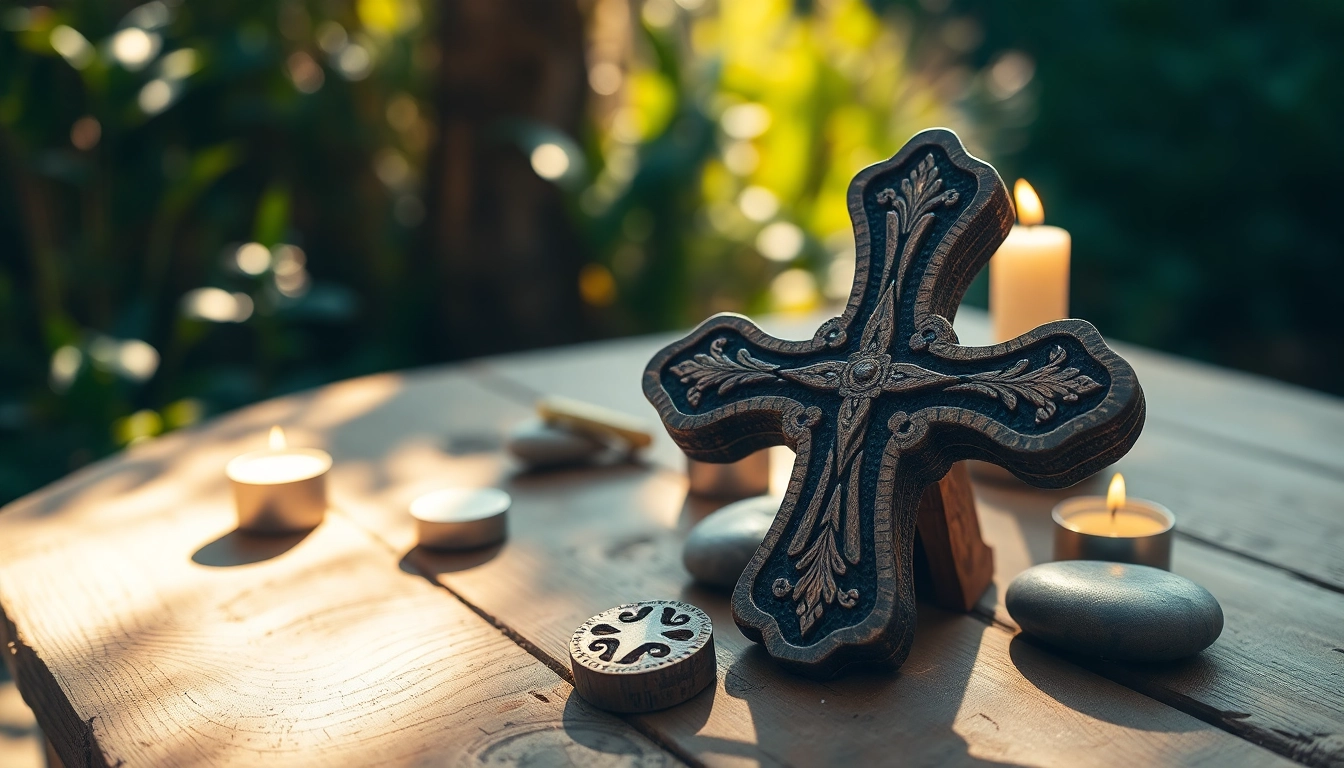Introduction to Handmade Crosses
In many cultures and religions, the cross symbolizes faith, hope, and divine connection. Among the various forms of crosses available, Handmade crosses stand out for their unique craftsmanship and personal significance. This article is dedicated to exploring the beauty, importance, and intricacies of handmade crosses, delving deep into their materials, craftsmanship, and the emotional connections they evoke.
What Are Handmade Crosses?
Handmade crosses are religious symbols crafted by artisans, reflecting their personal artistry and tradition. Unlike mass-produced items, each handmade cross carries distinct characteristics in design, material, and execution. They often serve not just as religious symbols but also as pieces of art that resonate deeply with faith and spirituality. By investing in a handmade cross, one supports art forms that have been passed down through generations and contributes to the livelihood of skilled artisans.
Importance of Handmade Crosses in Spirituality
The significance of crosses in various religions—especially Christianity—cannot be understated. While the symbol itself serves as a reminder of sacrifice, love, and salvation, the handmade aspect imbues it with further sentimental value. Many collectors, worshippers, and families choose handmade crosses as representations of their faith, ensuring that their spiritual expressions are uniquely their own. These crosses often become family heirlooms, passed down through generations, symbolizing continuity in faith and devotion. Additionally, many view handmade crosses as conduits for prayer and meditation, making them powerful tools for personal spiritual practices.
Overview of Materials Used in Handmade Crosses
Handmade crosses can be crafted from a variety of materials, each adding a unique element to the final piece. Some common materials include:
- Wood: Many handmade crosses are crafted from different types of wood such as olive, cedar, or pine. Olive wood, particularly from the Holy Land, is prized for its durability and beautiful grain.
- Metal: Some crosses incorporate metals such as iron or brass, which can be intricately designed and are often used for decorative pieces.
- Stone: Crosses made from natural stone convey a sense of geological permanence and are often used in traditional and rustic designs.
- Clay and Ceramics: Handmade crosses crafted from clay or ceramic allow for colorful, artistic designs that can be both whimsical and meaningful.
The Craftsmanship Behind Handmade Crosses
Traditional Techniques for Creating Handmade Crosses
Artisans utilize various traditional techniques derived from cultural practices in crafting handmade crosses. Many of these methods have been handed down through generations, ensuring authenticity and a connection to heritage. Techniques may include:
- Carving: This involves chiseling away material from a block of wood or stone to reveal the cross shape, often accompanied by intricate patterns or images.
- Inlay and Marquetry: Artisans use different types of wood or materials to create stunning designs by embedding them into the surface of the cross.
- Forging: For metal crosses, forging tools are used to shape and design each piece, making them strong and durable.
- Hand Painting: Some crosses, especially those made from ceramic or wood, are embellished with hand-painted designs that convey stories or symbols related to faith.
Modern Innovations in Cross Design
While traditional techniques remain popular, modern artisans also incorporate innovative designs and materials into their creations. This hybrid approach combines historical elegance with contemporary aesthetics, leading to unique and appealing pieces. Some innovations include:
- Mixed Media: Utilization of different materials in a single piece allows artisans to create visually striking crosses that merge wood, metal, and fabric.
- 3D Printing: Some modern creators experiment with 3D printing technology to produce intricate and customizable designs that were previously impossible with traditional methods.
- Sustainable Practices: Many artisans prioritize sustainability by using reclaimed materials or practicing eco-friendly manufacturing processes, appealing to environmentally conscious consumers.
The Role of Artisans in Handmade Cross Production
The artisans behind handmade crosses provide not just craftsmanship but also cultural preservation and economic benefits to their communities. Through their work, they forge connections spanning personal and spiritual planes. The process of creating these crosses is often labor-intensive and requires years of practice to perfect skills. Each piece often tells a story through its materials, design choices, and the artist’s personal touch.
In addition to their artistic contributions, artisans promote community engagement by running workshops, teaching others about the art of cross-making, and fostering appreciation for handmade crafts.
Choosing the Perfect Handmade Cross
Factors to Consider When Buying Handmade Crosses
When selecting a handmade cross, several factors should be considered to ensure it fits your aesthetic, spiritual, and functional needs:
- Size: Consider where the cross will be displayed. A larger cross may serve as a stunning focal point, while a smaller one might be better suited for a private meditation space.
- Material: Different materials yield varying aesthetic appeals and durability. For outdoor use, weather-resistant materials such as metal may be more suitable than wood.
- Design: Pay attention to design elements that speak personally to you—whether you favor minimalistic designs or more elaborate, decorative styles.
- Artisan Reputation: Research the artisans to ensure they prioritize quality and ethical production practices. Many online platforms showcase artisan profiles, including their stories and crafting methods.
Personalization Options for Handmade Crosses
Handmade crosses can often be personalized further to enhance their significance. Options can include:
- Engravings: Many artisans offer personalization through custom engravings, allowing you to add names, dates, or meaningful phrases.
- Color Choices: Some artisans allow you to choose colors or finishes that resonate with your aesthetic or the style of your home.
- Custom Designs: If you have a specific vision in mind, working with an artisan to create a completely unique cross can be incredibly rewarding.
Best Practices for Displaying Handmade Crosses at Home
Displaying a handmade cross in your home not only enhances your decor but also serves as a constant reminder of faith. Here are some best practices for displaying:
- Placement: Consider placing crosses in areas where they can be seen often, such as entryways, living rooms, or above mantels, to inspire reflection and prayer.
- Complementary Decor: Ensure that the cross complements surrounding decor. Align styles—whether rustic, modern, or traditional—for a cohesive aesthetic.
- Lighting: Proper lighting can enhance the beauty of the cross, creating a serene atmosphere. Consider spotlighting or using ambient lighting for display purposes.
Handmade Crosses as Gifts
Symbolism of Giving Handmade Crosses
Handmade crosses make thoughtful gifts that convey deep meaning. When gifted, they symbolize enduring faith, love, and thoughtfulness. The act of giving a handmade cross often holds spiritual weight as it reflects the giver’s commitment to the recipient and their shared beliefs.
Occasions for Gifting Handmade Crosses
Handmade crosses can be perfect gifts for numerous occasions, such as:
- Baptisms and Christenings: A handmade cross can serve as a cherished reminder of a child’s spiritual journey.
- Weddings: Couples may receive handmade crosses as a symbol of their union and faith.
- Anniversaries: Celebrating love and commitment with a handcrafted cross can carry significant emotional or spiritual importance.
- Housewarmings: A beautifully displayed cross can bless a new home, instilling a sense of peace and protection.
Unique Packaging Ideas for Handmade Cross Gifts
When gifting a handmade cross, presentation matters. Consider these creative packaging ideas that reflect the cross’s significance:
- Fabric Pouches: Use soft, beautiful fabrics for pouches, allowing the recipient to store the cross securely.
- Recycled Materials: Create eco-friendly packaging with recycled paper or materials, promoting sustainability while adding a rustic charm.
- Incorporating Notes: Write a heartfelt note explaining the significance of the cross and its meaning, providing personal context for the recipient.
Caring for Handmade Crosses
Maintenance Tips for Different Materials
Different materials require varied care to maintain the beauty and integrity of handmade crosses:
- Wood: Keep wooden crosses away from direct sunlight to prevent fading. Regular dusting with a soft, dry cloth and occasional use of wood oil can help maintain their finish.
- Metal: Use a gentle cleaner for metal crosses, avoiding harsh chemicals that may cause tarnishing. A microfiber cloth can aid in preventing scratches.
- Stone: Stone crosses should be cleaned with water and mild soap. Avoid harsh chemicals that might damage the surface.
How to Clean and Preserve Handmade Crosses
Cleaning and preserving your handmade cross not only keeps it looking beautiful but also extends its lifespan. Some general tips include:
- Regular Dusting: Establish a routine to dust your crosses regularly, preventing dust and dirt buildup.
- Avoid Extreme Conditions: Protect crosses from extreme heat or cold, as fluctuations in temperature can cause damage.
- Store Properly: When not on display, keep the cross in a safe location, away from heavy objects that could topple over or scratch.
Extending the Lifespan of Your Handmade Cross
To maintain the integrity of your handmade cross over time, consider the following strategies:
- Keepsake Boxes: Store smaller crosses in acid-free boxes or containers to avoid damage from humidity or insects.
- Insurance: For particularly valuable or meaningful pieces, consider insuring them, thus providing peace of mind.
- Regular Inspections: Check your crosses periodically for wear or damage to identify any needed repairs early on.



